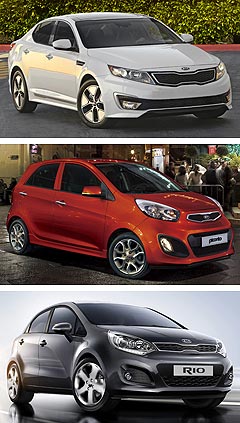News - KiaGeneva show: Kia designer keeps turning them outCovers off: Peter Schreyer stands next to the new Kia Rio in Geneva last week. Kia’s Schreyer says the sports car fun can wait until the Kia range is all ‘right’8 Mar 2011 THE architect of Kia’s design revolution, Peter Schreyer, came two steps closer to his ambition – to design a pure-bred sports car for the South Korean company – when the wraps came off the all-new Kia Rio light car and Picanto mini at the Geneva motor show last week. The former Audi and Volkswagen stylist – best known for penning the Audi TT and VW New Beetle for his former employer before he swapped companies in 2006 – has vowed to shelve the sports project until he and his team from Kia’s multiple design studios in Europe, California, Japan and South Korea have completed their task of reworking the entire current range of passenger cars and SUVs. “We have to make them right first before we do anything else,” Kia’s chief design officer said at the unveiling of the 2011 Rio and Picanto on the eve of the Geneva show. Asked if he was getting them right, Mr Schreyer quipped: “We don’t have to hide any more.” Dressed in his customary black, the German-born, Frankfurt-based Mr Schreyer would not be drawn on his ideas for a Kia sports car, instead preferring to talk about the latest Kia models revealed at Geneva. He said the Rio and Picanto both had effectively taken two steps up in styling evolution, instead of the customary one, lifting the entry-level cars to a new level. Mr Schreyer said the main objective of the restyling of both models had been to elevate the perception of quality, to make them look and feel more prestigious and substantial.  From top: Kia Optima hybrid, Kia Picanto, Kia Rio. From top: Kia Optima hybrid, Kia Picanto, Kia Rio.He said the work had taken about three years, bringing the two small hatches into line with other Kia models launched in the past three years, including the Sportage and Optima. The Rio – which arrives in Australia in five-door hatch form in about September – will also appear in sedan and three-door hatch variants, both of which are destined for Australian release within months of the five-door. Australia has its eyes on the five-door Picanto, although nothing has yet been confirmed. A three-door version that also made its debut at Geneva is unlikely to be added to the wish list. Next cab off the design rank for Mr Schreyer is likely to be a re-skin of the Soul – the boxy, youth-oriented, Californian-designed Kia that helped to put the previously dowdy company on the design radar. Mr Schreyer said re-designing the Soul was a more daunting task than other Kia models as, unlike most of the others, it already had road presence and fan base. The current Soul design predates Mr Schreyer’s tenure at Kia, having been based on a concept car shown at the 2006 Detroit motor show, ahead of its early 2009 launch. However, by the time Soul was launched it had gained an interpretation of the Schreyer trademark ‘tiger nose’ grille – more recently described as the tabbed grille – that has become more pronounced on subsequent models on which it is used to connect the range. Another all-new model coming down the chute is the all-new Cerato (known as the Forte in other markets) – a 2012 replacement for the current sedan designed by Tom Kearns at Kia’s California studio and launched in 2008. As well, the KV-7 concept car is expected to emerge as the next Carnival in late 2012, while the Sportage is set to get a mid-life spruce up in the next year or so. Meanwhile, the petrol-electric hybrid version of the Optima mid-sized sedan is still no closer to Australia, where the absence of a right-hand drive model is thwarting proposals to launch it here alongside the just-released conventional sedan. Kia Motors Australia (KMAu) national public relations manager Kevin Hepworth reiterated at the Geneva motor show, where the hybrid has just been given its European show debut, that while the Australian subsidiary would like to take it, it remained a left-hand-drive prospect only. “From the outset it was a US-based vehicle, to be built only in left-hand drive at the Georgia plant from the end of this year,” he said. “To change that, we would need some other right-hand drive markets, such as the UK and South Africa, to say ‘yes please’.” The Optima Hybrid, which was originally unveiled at the 2010 Los Angeles motor show, is powered by a 2.4-litre Theta II petrol engine paired with a small electric motor that drives the front wheels via a six-speed automatic transmission – without the traditional torque converter. A special clutch is fitted between the Optima Hybrid’s petrol engine and the electric motor, enabling the petrol engine to be de-coupled from the powertrain for full-electric drive at up to 100km/h.  Read more11th of February 2011  Geneva show: Kia unveils next-generation RioRio “combines European finesse with Korean spice” to continue Kia design revolution24th of January 2011  Kia heads upmarket with OptimaLuxurious new Optima a key part of Kia’s plan to grow sales and profit in 2011 |
Click to shareKia articlesResearch Kia Motor industry news |
















Facebook Twitter Instagram